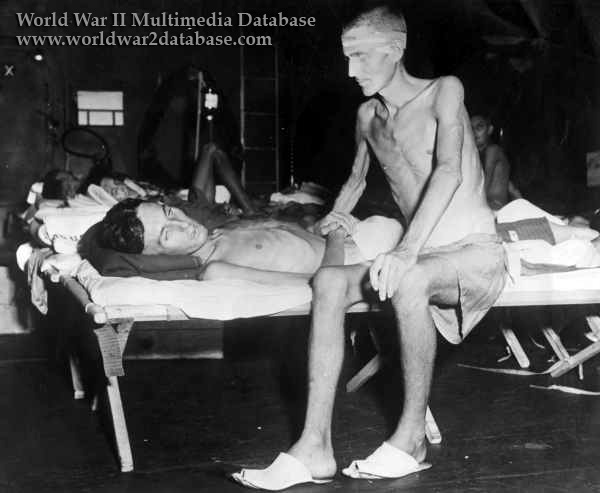| Two British survivors rest on USS Block Island (CVE-106). Before Japanese units on Formosa had formally surrendered, a multinational task force consisting of the USS Block Island (CVE-106), USS Brister (DE-327), USS Finch (DE-328), USS Kretchmer (DE-329), USS Santee (CVE-29), and USS Thomas J. Gary (DE-326) from the United States ; from Great Britain were the HMS Argonaut, HMS Barle, HMS Belfast, HMS Bermuda, HMS Colossus, HMS Helford, HMS Tumult, HMS Tuscan, HMS Tyrian and the Tanker San Amado; from Australia was the HMAS Quiberon; and from New Zealand was the HMNZHS Maunganui docked offshore of the port of Kiirun on September 5, 1945. the task group launched all available aircraft in case of trouble. The smaller ships docked and began to take on passengers to take out to the larger ships. Some 1500 American, British, Australian and New Zealand prisoners of war, held in various camps all over Taiwan, made their way by train to embark for Manila and medical care before going home. It took four days to embark everyone, and the hangar decks of the two carriers were turned into makeshift hospitals. Many of the former prisoners had to be carried on. The task force crews were stunned at the emaciated condition of most of the survivors. Maurice Cunningham, held since October 1942, said “Those sailors were marvellous, they helped every way they could, transferring us to boats by harness, then taken to aircraft carrier where as we crawled up gangway steps they manned every step of the way to help us up. I remember as I neared the deck hearing a band playing welcoming us aboard, each one of us individually, I almost burst into tears. I had never felt like this before. I was determined not to cry, I don‘t know how I managed. All I knew the Americans were to us like mothers to babies, they were on guard all night manning steps to latrines to make sure we were OK. It was there I saw myself in a mirror and scared myself.“ United States Navy Pharmacist‘s Mate First Class Bennie G. Owens said, “I have never worked so hard in my life as we did to prepare these men for transport to the DE‘s and then to the Carriers and then to hospitals in Manila. We had less than 24 hours to prepare them for transport. The condition of the POW‘s remains in mind to this day almost 60 years later. If anyone has any doubt as to the treatment that POW‘s at the hands of the Japanese, I can tell you that it was horrible.“ It took four days for the Allied navies to load all the men, leaving the worst cases to be stabilized and flown out. Many of these men were carried on board in their weakened state. USS Block Island‘s orchestra welcomed the prisoners with renditions of “God Save the King“ and “Rum and Coke-Cola.“ Despite the best efforts of medical staff on board, some of them still died in transit as a result of their internment. A muffled cheer went up as the ships cleared Kiirun. Arriving in Manila on September 11, many of the men needed mental as well as medical treatment, but to avoid stigmatizing the victims, mental services were not made available. Many of the survivors suffered from post-traumatic stress for many years. | |
| Image Filename | wwii1072.jpg |
| Image Size | 100.04 KB |
| Image Dimensions | 600 x 493 |
| Photographer | Unknown |
| Photographer Title | |
| Caption Author | Jason McDonald |
| Date Photographed | September 11, 1945 |
| Location | USS Block Island CVE-106 |
| City | Manila |
| State or Province | Luzon |
| Country | Philippines |
| Archive | United States Navy |
| Record Number | |
| Status | Caption ©2007, ©2024 MFA Productions LLC Image in the Public Domain |

Author of the World War II Multimedia Database

